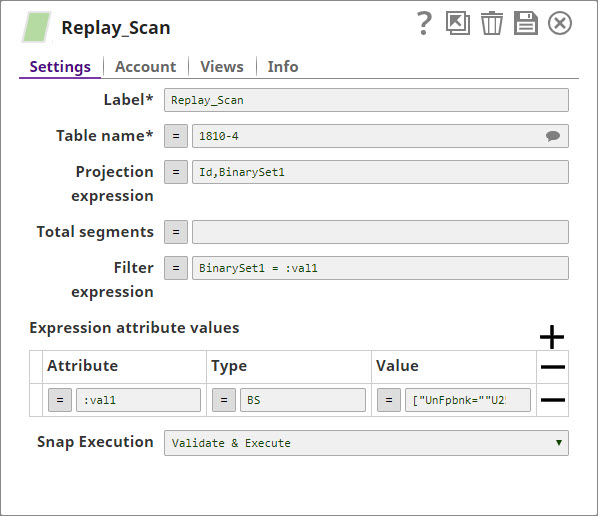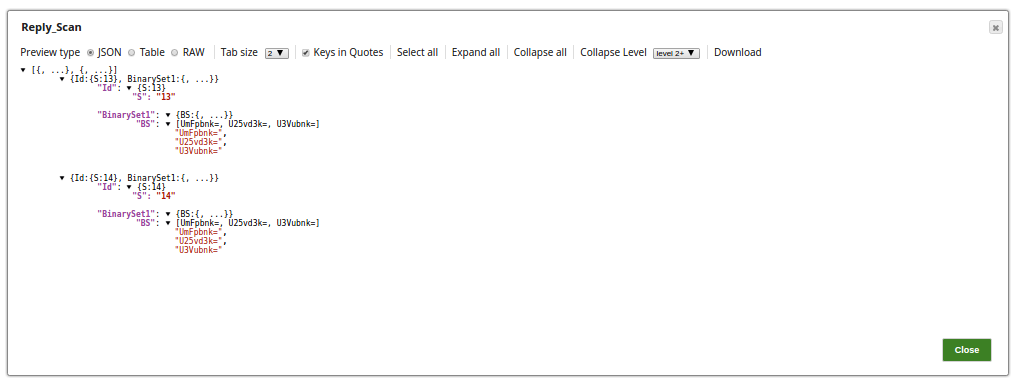On this Page
| Table of Contents | ||||
|---|---|---|---|---|
|
Snap type: | Read | |||||||||||||
|---|---|---|---|---|---|---|---|---|---|---|---|---|---|---|
Description: | This Snap provides the ability to read the data from DynamoDB table. The table becomes suggestible once the account is defined.
| |||||||||||||
| Prerequisites: | [None] | |||||||||||||
| Support and limitations: | Works in Ultra Task Pipelines. | |||||||||||||
| Account: | This Snap uses account references created on the Accounts page of SnapLogic Manager to handle access to this endpoint. See DynamoDB Account for information on setting up this type of account. | |||||||||||||
| Views: |
| |||||||||||||
Settings | ||||||||||||||
Label | Required. The name for the Snap. You can modify this to be more specific, especially if you have more than one of the same Snap in your pipeline. | |||||||||||||
Table name | Required. The name of the table to read the data from. This property is suggestible, which shows the list of the tables in the database. | |||||||||||||
Projection expression | Optional. String that identifies one or more attributes to retrieve from the specified table. If more than one attribute is to be retrieved then those should be separated by commas. | |||||||||||||
Total segments | Optional. This property represents the total number of segments into which the Scan operation will be divided for a parallel scan request.
Example: 2 | |||||||||||||
Filter expression | Optional. The condition that is used for filtering the table records. | |||||||||||||
| Expression attribute values | Specify the placeholders for the Expression Attribute Names and/or Expression Attribute Values.
Click + to enter:
Example If your table contains a column named uuid (a reserved word) and you want to read a value from the uuid column, then you must assign a placeholder for the column name because you cannot use a reserved word directly in your expression. We can define the Attribute #U, leave the Type blank, and enter the value as uuid. In the Snap Filter expression condition, we enter #U=:val1. :val1 is the placeholder for the value in the table which is defined as Attribute :val1 of Type B with Value dGhpcyB0ZXh0I.
| |||||||||||||
|
| |||||||||||||
| Expand | ||
|---|---|---|
| ||
DynamoDB Complex types:
A values of this type contains a set of strings delimited by double quotes as follows: Pattern: [String object 1, String object 2, ........, String Object n] Example: ["Snaplogic", "San Mateo", "Pipeline"] Number Set [NS] A value of this type contains a set of numbers delimited by double quotes as follows: Pattern: [Number Obj1, Number Object2,...., Number Object n] Example: ["123", "24.56", "-35", "-21.456","0"] Binary Set [BS] A value of this type contains a set of base64-encoded binary data objects delimited by double quotes as follows: Pattern: [ Binary Object 1, Binary Object 2,...Binary Object n] Example: ["U3Vubnk=", "UmFpbnk=", "U25vd3k="] List (L): Pattern: [ object 1, object 2, ........, Object n] Example: [{"N":"3"},{"S":"-7.5"},{"B":"U3Vubnk="},{"L":[{"N":"-45.56"},{"M":{"Name":{"S":"ahmed"}}}]},{"M":{"name":{"S":"syed"}}},{"SS":["a","b"]},{"BS":["U3Vubnk="]},{"NS":["23","45"]}] Map(M): A value of this type contains a set of key- value pairs. Keys are always strings, whereas values can be of any type (String, Number, String Set, Map, List etc.,). In general, the Map object resembles a JSON array. Example: {"id":{"S":"snaplogic"}, "orgs":{"L":[{"S":"uat"}, {"S":"qa"}]}, "admins":{"L":[{"M":{"name":{"S":"a"}}}, {"M":{"name":{"S":"45"}}}]}} Using the Binary Set types for the DynamoDB Scan Snap: |
Example
The following image shows a sample pipeline:
Sample output of the Snap is as shown below:
| Insert excerpt | ||||||
|---|---|---|---|---|---|---|
|




